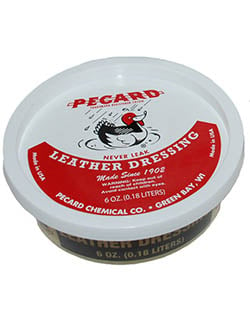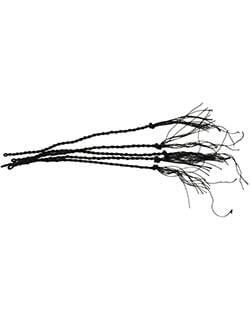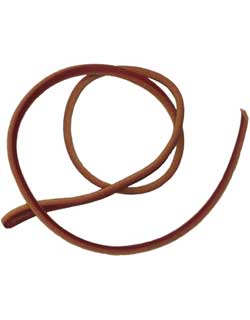Care of Whips
Good whips, properly used and maintained, should give long service. Physical damage such as hitting on sharp objects, gravel, concrete etc., being jammed in doors or truck tailgates, or chewed by dogs or poddy calves, obviously will destroy a whip quickly. Care in three other aspects will help you gain the most from your braided leather whip.
1. Dirt and sand embedded in the whip will cause internal wear. Dirt can be washed out with warm soapy water, the whip dried (without heat) and then given a heavy coat of leather dressing.
2. Using the whip with excessive force, as in seeking the loudest possible crack, will cause early breakage of falls and stretch the thong, so altering the taper. The usual and preferred crack is that attained with minimum force. A strong wrist action will over-stress the keeper on a stock whip or the junction of thong to butt section on a bullwhip, and will cause early failure. Normal use of these whips should employ very little wrist force.
3. Leather dressing is important. A dry whip loses its strength, and one with the wrong dressing may lose strength and/or stretch out of shape. Do not dress a whip with tallow, neatsfoot oil, or any light oils. We recommend Pecard Leather Dressing. Whips to be stored should be kept in light cool conditions, and given a thin coat of Pecard Dressing every six months. Whips in use may be dressed somewhat more often. Whips used in hot, dry, or dusty conditions, and whips used in the wet, may need frequent dressing. Falls on whips last better if kept well dressed at all times.
Bullwhip and Stock Whip Falls and Crackers
Falls and crackers take the brunt of the wear when a whip is used, and require
replacement as needed. The end of the fall wears off, shortening the fall.
Depending upon use, a fall worn down to under 12 - 18 inches needs replacing.
Falls also stretch and thin down, and should be replaced when they have
become noticeably thinner than the end of the thong. Red hide falls tend
more to hold their thickness but to break off, white hide falls tend to
stretch more but break off more slowly, and need watching for getting too
thin. In addition, the kangaroo strands adjacent to the fall will in time
break because of the sharp flexing at this point. The fall should be replaced
as soon as the first strand breaks. You may easily replace falls yourself, following the directions linked below for our leather whips.
![]() Attaching
a New Whip Cracker
Attaching
a New Whip Cracker
![]() Replacement
of Falls
Replacement
of Falls
![]() Spare Parts
for Whips: Crackers, Red
Hide Whip Fall, White Hide
Whip Fall
Spare Parts
for Whips: Crackers, Red
Hide Whip Fall, White Hide
Whip Fall
You may return the whip to our leather workshop for such replacement. This service is limited to whips in good condition purchased from David Morgan. [See Whip Repair Services.]
Care and Maintenance of Signal Whips
Signal whips should be held with the knob at the end in the palm of the hand,
with the whip allowed to swivel in the hand so as to reduce the bending stress
in the thong near the knob. If the whip is held firmly in the hand, and the
thong forced to bend severely near the knob, the whip will fail prematurely
in the area of excess bending.
The ends of the braided leather buried under the thread of the cracker will poke out as the whip is cracked. this is no cause for concern. The thread is much more elastic than the leather, and so when the whip is cracked the thread tends to creep out over the leather ends and allow the ends to poke out. There are three knots holding the ends of the strands, spaced to ensure that the whip does not unravel. It is best to leave the ends that poke out, and not to trim them off.
When the fluff on the end of the cracker wears down to the knot, this knot may be undone or cut, to form a second fluff which may be worn down to the next knot, at which time the cracker should be replaced.
We will replace braided crackers when needed. This service is limited to signal whips in good condition purchased from David Morgan. [See Whip Repair Services.]
Care of Old Whips
If you come upon an old whip, treat it with understanding. If a whip has been
stored it is probably dried out, and the leather may have deteriorated to the
point of fragility. The general rule is that if a whip has value as a collectable,
trying it out, cracking or using it may radically reduce its value.
Whips which are very old and dry should be treated as wall hangers. If you have such a whip, do not attempt to crack it ever, and do not unroll, bend or flex it until you have greased it heavily with Pecard Dressing and allowed a couple of weeks for the dressing to soak in. It may be then uncoiled or flexed gently, and if appropriate, excess Pecard removed with a soft cloth and the whip polished gently. If you feel the need to try out the whip, make a copy and try out the copy. Many old whips, worthy of preservation in a collection, are ruined by just one ill advised attempt to try them out when the leather had been weakened by the inevitable oxidation occurring in a dry whip.
Whips which are old but have been kept greased may or may not have lost their strength. If the whip is of no value as a collectable it may be given an extra coat of Pecard Dressing and, after allowing time for the dressing to penetrate well, it may be used. If weak it will fall apart, if strong it should hold together.
If it is desirable to maintain the integrity of the whip, it should be treated more gently in dressing it, more time allowed for penetration of the dressing. Before the whip is tried out a small section of a strand, as at the point where the fall is tied on, should be tested for strength. If this strand is weak, assume the entire whip is too weak to try out. If this strand is strong it is probably safe to try out the whip gently, noting that the whip may still be damaged. The general rule is that if a whip has value as a collectable, trying it out, cracking or using it may radically reduce its value.
Care of Synthetic Whips
Synthetic whips are maintenance free. They can be washed with water and used while wet. They can be used in wet, muddy or in snowy conditions. The thong is totally synthetic, so there is no potential for rot and it cannot be cut or broken easily.
For more information ...
Please follow the links below for more information concerning our whips, braided
goods and related information.
![]() Selecting
Your First Whip for Sport Cracking
Selecting
Your First Whip for Sport Cracking
 The Art of Whip Cracking
The Art of Whip Cracking
![]() Whip Repair Services
Whip Repair Services
![]() Care
of Fine Leather
Care
of Fine Leather
![]() Attaching a New Whip Cracker, Replacement
of Falls
Attaching a New Whip Cracker, Replacement
of Falls
![]() Whip
Frequently Asked Questions
Whip
Frequently Asked Questions
![]() Braided
Goods
Braided
Goods
![]() Bullwhips
Bullwhips
![]() Pocket Snakes
Pocket Snakes
![]() Stock
Whips
Stock
Whips
![]() Quirts
Quirts
![]() Whips
and Whipmaking
Whips
and Whipmaking
![]() Braiding
Supplies
Braiding
Supplies





